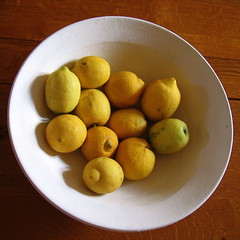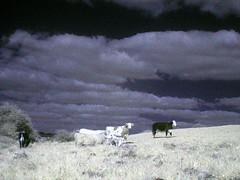To make preserved lemons, first of all obtain some fresh, organic lemons. No wax or preservatives if you can source them. Wash and scrub them very thoroughly, and prepare a sterile jar with an airtight lid for storage. You’ll also need salt. Lots of salt.
Next, with your Best Pocket Knife, slice the lemon along its long axis almost to the end, then turn it around, roll it through 90 degrees and slice it along its other long axis almost to the end. So now you’ve got this almost-sliced-through lemon into which you pack your salt. It doesn’t matter if it starts spilling out, just direct the spillage into the jar but pack the lemon full of salt. Repeat this untill you’ve filled your jar or almost run out of lemons. Juice the last lemon (or lemons) and top off the jar with this juice. Add a little more salt if you feel daring. Seal the jar.
Next comes the waiting. Keep your sealed jar on a shelf at room temperature for six weeks. Turn it lovingly every day to redistribute the juice and dissolved salt. It’ll be cloudy, and sometimes you’ll see a white waxy substance leeching out of the lemon skin, possibly a reaction involving the lemons’ oils – this is OK. The atmosphere inside the jar is so saline and acidic that nothing bad can grow in there.
After six weeks, your preserved lemons are ready to use. Open the jar and take out however much you need – a little goes a long way – remove the flesh and discard, and wash the lemon rind thoroughly. Slice very thinly and add to your dish. Make like that scene in Goodfellas where Paulie shaves the garlic with a razor.
I use preserved lemon a lot with couscous and grilled poultry, it’s traditional home is Morocco, and so it’s common in North African dishes. Perhaps it’d work with more robust meaty flavours too – I haven’t tried, but I think it would overpower fish. I’m also thinking about introducing other flavours to the mix, maybe a little cumin seed, coriander seed, pepper, garlic, but I haven’t got round to this yet.







